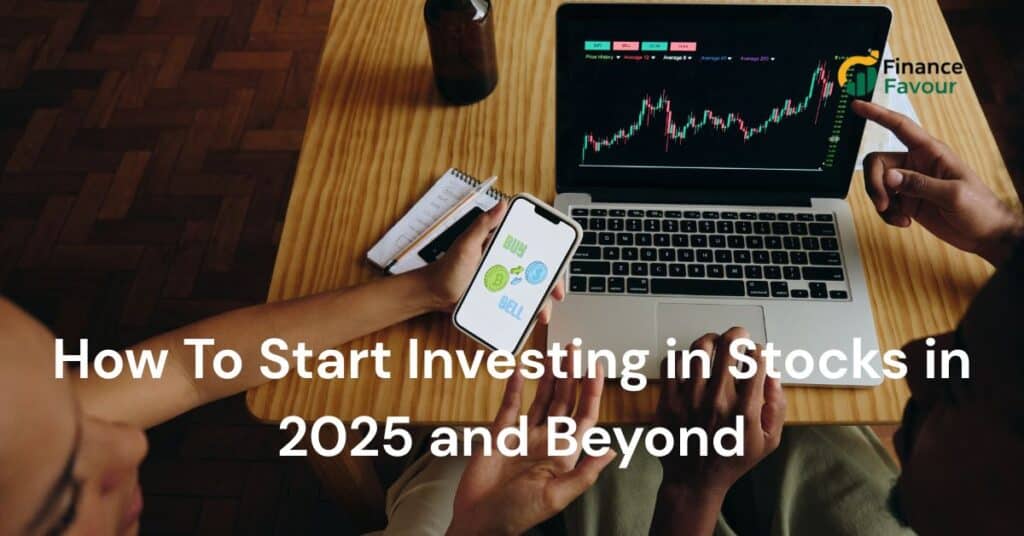Are you dreaming of growing your wealth or securing a stress-free retirement? You’re not alone and you’re in the right place. The world of stock investing might seem like a financial jungle, but trust me, it’s more like a well-mapped trail once you know where to step. Whether you’re a total beginner or just need a 2025-style refresh, this guide is your GPS. Let’s dive in step by step and set you up for a smarter financial future.
Understanding the Basics of Stock Investing
What is a Stock?
A stock represents a small piece of ownership in a company. When you buy a stock, you’re buying a slice of a corporation essentially, you become a shareholder. This means you’re entitled to a portion of the company’s assets and profits, proportionate to how much stock you own. Pretty cool, right?
Stocks are issued by companies to raise capital. In return, investors receive shares that fluctuate in value depending on the company’s performance and market trends. These shares are traded on public exchanges like the NYSE or NASDAQ. So, when people talk about “playing the stock market,” this is what they mean.
It’s important to understand that owning stock doesn’t mean you have a say in daily operations. However, some stocks come with voting rights in shareholder meetings, particularly common stocks. Others, like preferred stocks, don’t offer voting rights but often pay higher dividends. We’ll touch more on that shortly.
Bottom line: Buying a stock gives you a stake in a company’s success (and sometimes failure). It’s a foundational concept and a gateway to building long-term wealth.
How Do Stocks Work?
Let’s demystify it. Stocks are traded in markets where prices are determined by supply and demand. When many investors want to buy a stock, the price goes up. When more people want to sell, it goes down. Think of it like an auction only it’s happening every second the markets are open.
Companies can also pay dividends to their shareholders, which are typically quarterly payments made from profits. Some investors focus on these income-generating stocks, while others prefer growth stocks that reinvest profits to expand.
In 2025, many investors are leaning into innovative sectors like AI, renewable energy, and biotech. These industries are shaping the future, and savvy stock pickers are hopping on early.
Another thing when you buy stocks, especially if you’re using apps or brokers, you’ll notice terms like “market order” or “limit order.” These are just ways to control how and when your trades go through. A market order buys/sells at the current price. A limit order waits for a price you specify.
Understanding how stocks work gives you the power to make informed decisions and that’s half the battle won.
Types of Stocks You Can Invest In
The stock market isn’t a one-size-fits-all landscape. Different stocks offer different opportunities and levels of risk. Here’s a quick breakdown:
- Common Stocks: These are the most typical type. You get voting rights and potential dividends. The price can swing significantly based on company performance and market trends.
- Preferred Stocks: Less volatile, more predictable dividends, but usually no voting rights. Great for conservative investors.
- Growth Stocks: Think tech companies that are expanding fast. These usually don’t pay dividends because profits are reinvested. They’re risky but can be hugely rewarding.
- Dividend Stocks: These pay out profits regularly, making them ideal for investors seeking income.
- Blue-Chip Stocks: Stable, established companies with a solid history. Think Apple, Microsoft, or Coca-Cola. They’re the backbone of many portfolios.
- Penny Stocks: Priced under $5, these are high-risk, high-reward investments. Beware they’re often volatile and can be easily manipulated.
Diversifying across different stock types can help you manage risk while positioning your portfolio for growth. In 2025, it’s also important to consider environmental, social, and governance (ESG) factors ethical investing is on the rise, and many investors now choose companies that align with their values.
Why 2025 is the Perfect Time to Start Investing
Market Trends and Technological Advancements
2025 isn’t just another year it’s a game-changer for investing. We’re in the middle of a tech revolution, and it’s creating golden opportunities. AI, quantum computing, blockchain, and clean energy are transforming how we live and invest.
The stock market has rebounded from past turbulence and is now more data-driven than ever. With the rise of predictive analytics, investors have smarter tools to make informed decisions. Robo-advisors use AI to help manage portfolios based on your risk profile and goals. It’s like having a financial planner in your pocket.
Meanwhile, the global economy is stabilizing post-pandemic, and new markets are emerging. Companies are going green, and sectors like electric vehicles, renewable energy, and healthcare innovation are booming. These are not just trends—they’re becoming long-term pillars of growth.
So if you’ve been waiting for the right time, this is it. There’s a seat at the table for everyone.
Accessibility and Democratization of Investing
Remember when investing meant calling a broker or needing thousands of dollars just to get started? Those days are gone. In 2025, anyone with a smartphone and a few bucks can start investing.
Thanks to apps like Robinhood, Webull, and eToro, commission-free trading is the norm. Fractional shares let you invest in expensive stocks with just $1. So yes, you can own a piece of Amazon or Tesla without breaking the bank.
Social media and investing communities are also making knowledge more accessible. Platforms like Reddit, YouTube, and Discord groups are creating financial tribes where beginners can learn the ropes.
Investing has truly become a tool for everyone, not just the wealthy elite. That’s the power of democratization and it’s only getting better.
Increasing Financial Literacy
Here’s the kicker: people are getting smarter about money. Schools are starting to include personal finance in curriculums. Influencers are spreading awareness. And free tools like budget planners, risk calculators, and market simulators are everywhere.
In 2025, the average investor is more informed and empowered than ever before. Whether you’re 18 or 58, resources are out there to help you learn, practice, and grow.
Being financially literate isn’t a bonus anymore it’s essential. When you understand how money works, you stop fearing the stock market and start seeing it as an ally.
Setting Your Financial Goals Before Investing
Short-Term vs Long-Term Goals
Before you put a single dollar into the market, take a moment to reflect: What are you investing for? Is it a new car in the next few years, your kid’s college tuition, or maybe your dream retirement? Your investment goals should dictate your entire strategy.
Short-term goals (1–5 years) usually require safer investments. You won’t want your money in high-volatility stocks if you plan to use it soon. Think bonds, high-yield savings, or conservative ETFs.
Long-term goals (5+ years), like retirement or wealth building, are where stocks truly shine. Over the long haul, the market tends to rise, despite occasional dips. This gives your money time to grow and recover from any downturns.
Establishing a timeline also helps you stay focused. Say your goal is to buy a house in 10 years. That long-term lens keeps you from panic-selling when the market fluctuates. Your goal becomes your guide.
Here’s a tip: Write down your goals, how much money you’ll need, and when you’ll need it. Then match your investment choices to those specifics. That’s how you stay aligned and motivated.
Risk Tolerance and Investment Strategy
Risk tolerance is like your financial personality. Are you cool as a cucumber when your stocks dip 10%, or do you break into a cold sweat? Knowing your comfort level helps you choose investments that won’t keep you up at night.
There are three broad risk profiles:
- Conservative – Low risk, stable returns. Think bonds, blue-chip stocks, dividend ETFs.
- Moderate – Balanced approach. Some growth stocks, some stability.
- Aggressive – High risk, high potential reward. Think small caps, emerging markets, tech.
Your age, income, savings, and financial obligations all play a role here. A 25-year-old might go aggressive because they have time to recover. A 60-year-old near retirement? Not so much.
Once you know your risk level, pick a matching strategy:
- Value Investing: Buying undervalued stocks for long-term growth.
- Growth Investing: Targeting companies poised for rapid expansion.
- Income Investing: Seeking steady dividend payouts.
- Index Investing: Low-cost, passive exposure to the whole market.
2025 also offers “thematic investing.” Want to bet on the future of AI or space exploration? There’s an ETF for that. Strategy is everything it’s your personal game plan.
Building an Investment Plan
Now let’s put it all together. Your investment plan is the bridge between your goals and action. It’s a living document that outlines:
- Your financial objectives
- Investment horizon (timeline)
- Risk tolerance
- Asset allocation (stocks vs bonds vs alternatives)
- Monthly or annual contribution targets
- Rebalancing frequency (quarterly, annually, etc.)
Start small and scale up. Let’s say you decide to invest $200 a month in a diversified portfolio. That might include:
- 50% in a broad-market ETF (like VTI or SPY)
- 20% in a dividend ETF
- 15% in tech or innovation-based stocks
- 10% in international markets
- 5% in cash or short-term bonds
Revisit your plan yearly to tweak allocations based on performance or changing life circumstances. It’s your roadmap to financial independence—so make it solid, make it yours.
Choosing the Right Investment Account
Taxable Brokerage Accounts vs Retirement Accounts
One of the most overlooked steps in stock investing is choosing the right type of account. It’s not just about where you invest it’s about how it affects your taxes.
Taxable brokerage accounts are your most flexible option. You can deposit and withdraw anytime. The catch? You’ll pay taxes on capital gains (profits from selling stock) and dividends. Still, for most beginners, it’s a great place to start.
Retirement accounts like Roth IRAs, Traditional IRAs, or 401(k)s offer serious tax perks:
- Roth IRA: Invest post-tax money. No taxes on withdrawals if rules are followed. Great for young investors.
- Traditional IRA: Contributions are tax-deductible, but you’ll pay taxes on withdrawals later.
- 401(k): Employer-sponsored plan with potential matching contributions. Often has fewer investment choices but is a must if your company offers a match.
Each account serves a purpose. Want to retire rich? Open an IRA. Want to dabble and learn? Start with a taxable account. Or better yet do both.
Best Online Platforms and Apps in 2025
The digital revolution has redefined investing. In 2025, you have countless platforms that offer seamless user experiences, educational tools, and zero-commission trades. Here are a few top picks:
- Robinhood: User-friendly and perfect for beginners. Offers stocks, crypto, options.
- Fidelity: Strong research tools, great for all levels.
- eToro: Known for social trading you can copy top investors.
- Webull: Advanced charts, great for intermediate users.
- M1 Finance: Ideal for long-term, goal-based investing with automatic rebalancing.
All these platforms offer mobile apps, instant deposits, and educational content. Your choice depends on your style whether you’re hands-on or prefer automation.
Compare platforms based on:
- Fees (including hidden ones)
- Ease of use
- Investment options (stocks, ETFs, crypto, etc.)
- Tools and research access
- Customer service
Most importantly, choose one that fits your learning curve and goals.
How to Set Up Your First Investment Account
Ready to roll? Here’s how to open your first account in under 15 minutes:
- Choose your broker: Pick from the ones mentioned above based on your needs.
- Gather documents: You’ll need an ID, Social Security number, and bank info.
- Create an account: Follow the signup steps on the broker’s website or app.
- Answer profile questions: Risk tolerance, investment goals, income level. This helps tailor recommendations.
- Fund your account: Link your bank and deposit money some brokers let you start with as little as $1.
- Start investing: You can buy whole shares or fractional ones. Start small and build confidence.
Pro tip: Don’t rush. Explore the dashboard. Read the insights. Watch how your first investment performs. Investing isn’t a race it’s a marathon.
Learning to Research and Pick Stocks
Fundamental Analysis Explained
Before you invest in a stock, you need to know what makes it tick. That’s where fundamental analysis comes in it’s the art of evaluating a company’s health and growth potential.
Key indicators include:
- Earnings per Share (EPS): Profit per share. Higher is better.
- Price-to-Earnings Ratio (P/E): Tells you how a stock’s price compares to its earnings. A lower ratio can indicate a bargain.
- Revenue Growth: Consistent growth is a strong sign.
- Debt Levels: Too much debt is a red flag.
- Profit Margins: Shows efficiency higher margins mean better performance.
- Management and Leadership: Good companies are led by visionary teams.
Read quarterly reports, check financial statements, and use tools like Yahoo Finance or your brokerage app. Don’t blindly follow hype follow the numbers.
In 2025, AI-powered tools make this even easier. Platforms now use machine learning to offer stock ratings, risk scores, and predictions. Use them to supplement, not replace, your own research.
Technical Analysis Basics
While fundamental analysis looks at the company, technical analysis focuses on the stock’s price behavior. This strategy uses charts, indicators, and historical data to predict future movements. Sounds complex? Don’t worry—it’s easier than it looks.
Here are a few core concepts:
- Candlestick Charts: These show a stock’s high, low, open, and close price in a given time. Patterns like “doji,” “hammer,” or “engulfing” signal potential reversals or trends.
- Moving Averages: Helps smooth out price data. A 50-day or 200-day moving average is often used to identify trends.
- Relative Strength Index (RSI): Measures whether a stock is overbought or oversold. An RSI above 70 suggests overbought; below 30 means oversold.
- MACD (Moving Average Convergence Divergence): Shows the relationship between two moving averages. When lines cross, it signals a potential buy or sell.
Traders use these tools to make short-term decisions. Even long-term investors can benefit by timing their entries and exits more wisely.
In 2025, many apps have built-in charting tools. Practice by looking at historical charts of popular stocks. Watch how indicators behave during bull and bear markets. It’s like reading a stock’s diary it tells a story you can learn from.
Using News and Financial Reports
Never underestimate the power of information. News headlines can send stocks soaring or crashing in minutes. But smart investors don’t react they anticipate.
Keep tabs on:
- Earnings Reports: Published quarterly, these show how a company performed. Beat expectations? Stock goes up. Miss? Stock drops.
- Mergers & Acquisitions: Companies combining or buying others often signal growth (or trouble).
- Regulatory News: New laws or restrictions can impact entire industries think healthcare, crypto, or green energy.
- Macroeconomic Reports: Interest rates, inflation, and unemployment data shape the overall market.
Follow trusted financial sites like Bloomberg, CNBC, and MarketWatch. Set up Google Alerts for companies or industries you’re watching.
Also, consider reading annual reports (10-K filings) and quarterly updates (10-Q filings). They’re dry, but full of gold like financial health, strategies, and risks.
2025 bonus: AI-powered news aggregators can deliver curated, real-time updates based on your portfolio or watchlist. No more info overload—just what matters to you.
Conclusion
Investing in stocks in 2025 isn’t just for Wall Street pros it’s for anyone with a goal, a plan, and a little patience. Whether you’re 18 or 80, the doors to financial independence are wide open. With the tech, tools, and knowledge now available, there’s never been a better time to start.
Remember: success doesn’t come from timing the market it comes from time in the market. Educate yourself, stay consistent, and don’t panic at every dip. Every investor was a beginner once, and the best time to start was yesterday. The second-best time? Today.
So go ahead, open that account, buy your first share, and begin your journey toward building real wealth. Your future self will thank you.
Checkout other post Real Estate Syndicates a Good Investment
FAQs
You can start with as little as $1 thanks to fractional shares and commission-free trading platforms. The key is consistency, not the amount.
While stocks carry risk, they are among the best long-term investments. Start with diversified ETFs or blue-chip stocks to reduce volatility.
There’s no one-size-fits-all answer. Focus on your goals, research thoroughly, and consider sectors like tech, green energy, or healthcare that show strong growth.
Yes, but prioritize paying off high-interest debt first. Then invest small amounts to start building your portfolio while managing debt responsibly.
Profits from stocks are subject to capital gains tax. Short-term (held under a year) is taxed at your income rate; long-term (over a year) gets a lower rate. Dividends may also be taxed.




